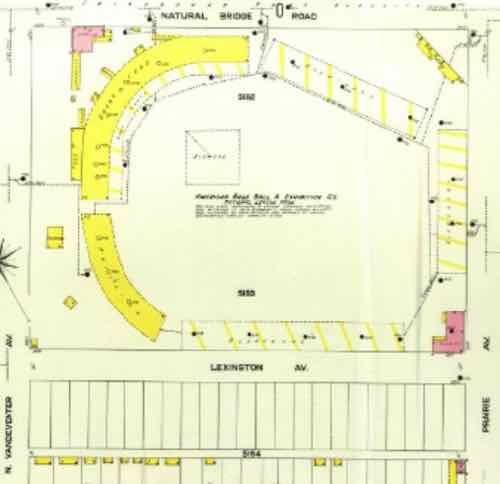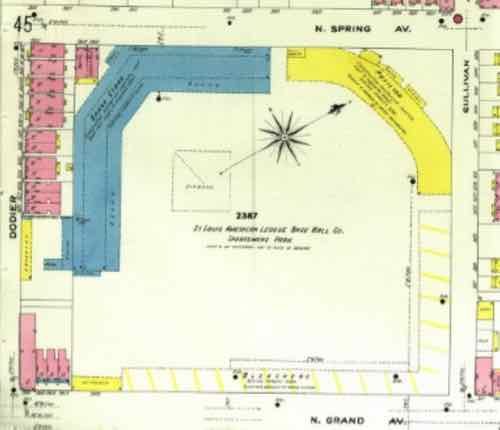Sportsman’s Park (later known as Busch Stadium) Reopened 120 Years Ago Today
The baseball diamond bounded by Dodier, Grand, Sullivan, and Spring is commonly called Sportsman’s Park, but it has had many names during the century prior to the Herbert Hoover Boys Club taking over the site. When I decided to write a post about this I naïvely thought it would be fairly simple to do. Instead it got more complicated (and interesting) than I anticipated.

This post will be about this location, plus some others where baseball has been played in St. Louis — not about the sport or some great play in a game. This post is presented as a chronological timeline, but there are many gaps & details not researched. At the end I’ll discuss the urban planning issues around these sites, such as building codes, land use, zoning, public transit, parking, etc.
The following is from various sources, not all independently verified.
- October 16 1834: Augustus Solari born in Switzerland. He’s an important figure in St. Louis baseball stadiums…keep reading.
- 1860: Solari marries Louisa Sartore. She was also born in Switzerland (1837). Wedding location unknown.
- 1866: Augustus Solari acquires land in St. Louis that will eventually become Sportsman’s Park. He’s a recent immigrant, 31 or 32 years old at the time and a father of 3 at this point.
- 1867: Augustus Solari begins staging baseball games at the Grand Avenue Ball Grounds (also known as Grand Avenue Park).
- 1870: St. Louis population 310,864.
- June 1874: A judge will hear the case of John Dee against saloon proprietor Augustus Solari. Dee alleged Solari assaulted him with a stick, was unprovoked. Apparently this saloon was at the ball park.
- 1875: St. Louis Brown Stockings formed in St. Louis, began playing at the Grand Avenue Ball Park. St. Louis has one major all-white baseball team. Founders/ownership is unclear but it doesn’t appear Solari was involved.
- 1877: “After the conclusion of the 1877 season, a game-fixing scandal involving two players the Brown Stockings had acquired led the team to resign its membership in the NL. The club then declared bankruptcy and folded.”
- April 14, 1878: St. Louis Brown Stockings defeat the Athletics, 2,600 “witnesses”.
- May 1879: the National League and the team fold.
- June 1879: Solari helps reorganize the St. Louis Brown Stockings.
- 1880: St. Louis population 350,518.
- July 25, 1881: The circuit court issued issued an injunction preventing a planned pigeon shoot near the fields. Augustus Solari and others are mentioned in the page 8 story titled “Pity for Pigeons.”
- 1881: First grandstand constructed of wood, located at southeast corner closest to Grand & Dodier. As you’d expect the home plate is in this corner.
- 1881: Grocery store and saloon owner Christian Friedrich von der Ahe (1851-1913) bought the St. Louis Brown Stockings when he was in his early 30s. Changes team name to the St. Louis Browns.
- 1882: St. Louis Browns become part of the American Association league.October 2, 1883: Supreme Court (state? federal?) overturns lower courts, giving possession of the Grand Avenue Base Ball Park back to the descendants of George C. Miller and tenant Augustus Solari.
- 1890: 451,770 population.
- 1892: When the American Association folded St. Louis Browns was among teams included in a new National League. The team began looking for a new place to play.
- “For 1893, owner Chris von der Ahe moved his team a few blocks to the northwest and opened a “New” Sportsman’s Park, on the southeast corner of Natural Bridge and Vandeventer. The move to this particular site was part of a “deal”, as the property had been owned by a trolley company, who then ran a trolley line out near the ballpark. The diamond was in the northwest corner of the block. Prairie Avenue was the east (left field) border. Right field, the shorter of the outfields, was bordered by Lexington Avenue.The ballpark was generations ahead of its time in some ways. Along with the basic stands, Von der Ahe had built an adjoining amusement park, a beer garden, a race track in the outfield, a “shoot-the-shoots” water flume ride, and an artificial lake (used for ice skating in winter). The side show notwithstanding, the club performed poorly on the field for most of the 1890s, consistently finishing at or near last place in the 12-team league as Von der Ahe sold off his best players in order to keep the club solvent.”
- April 27, 1893: After nearly two decades at Sportsman’s Park (Grand & Dodier) the St. Louis Browns play at their new ballpark for the very first time. The original Sportsman’s Park becomes the Old Sportsman’s Park, later Athletic Field.

- April 16, 1898 a dropped cigar catches the wooden grandstand at the New Sportsman’s Park on fire.
- May 11, 1898: Augustus Solari dies at age 63. Two of his eight children preceded him in death, one just four months earlier.
- 1899: Cardinals owner Chris von der Ahe files for bankruptcy, forced to sell team. Brothers Frank & Stanley Robison purchase the team and New Sportsman’s Park. They rename the ballpark (Vandeventer & Natural Bridge) as League Park.
- March 28, 1899: August Anheuser Busch Jr. born.
- 1900: The 1900 census showed the St. Louis population at 575,238 — a 28.9% increase since the 1890 census of 451,770.
- May 4, 1901: Another fire at League Park, formerly New Sportsman’s Park. The Cardinals played the next day at the Old Sportsman’s Park (aka Athletic Field) and then on the road while their ballpark was being rebuilt.
- 1902: The Milwaukee Brewers move to St. Louis and become the St. Louis Browns. This was okay because the Browns many in St. Louis knew were now the Cardinals, with the color red instead of brown.
- April 23, 1902: the ballpark reopens with a new grandstand and home plate on the northwest corner, Spring & Sullivan.
- 1909: A new concrete & steel grandstand is built, it and the home plate are in the southwest corner. This was the 3rd major stadium with a modern concrete and steel grandstand. The home plate remained in the southwest corner until May 1966 when it was flown to Busch Stadium II.

- 1909: Bicycle shop owner William Carter started Carter Carburetor. Business location unknown — but it was NOT in the block south of Sportsman’s Park.
- 1910: population: 687,029
- 1911: Frank Robison’s daughter inherited the Cardinals from her uncle Stanley, following his death. Presumably Frank Robison died before his brother.
- 1913-1915: Former player Branch Rickey becomes general manager of the St. Louis Browns — the team that moved to St. Louis in 1902.
- 1917-1919: World War I.
- 1919: After a brief return to the St. Louis Browns as general manager, Branch Rickey becomes the general manager of the St. Louis Cardinals.
- 1920: population: 772, 897
- June 6, 1920: The St. Louis Cardinals last game at their mostly wood Robison Field. The land was sold, Beaumont High School was built on the site in 1924.
- 1920: Negro team the St. Louis Giants played a best of seven series against the Cardinals at Sportsman’s Park. The Cardinals won 4 games, the Stars 1. The Giants and later Stars home field was at Compton & Laclede — now a diamond for Harris Stowe University.
- 1922: St. Charles -based American Car and Foundry Company purchases Carter Carburetor. At some point in the 1920s they built offices & factories on Spring at St. Louis Ave. — a block south of Dodier from Sportsman’s Park.
- 1928: Carter Carburator Co, a subsidiary of ACF, builds headquarters at 711 N. Grand — a little over a mile south of their factory.
- 1930: population of 821, 960
- 1936: “Browns owner Phil Ball died. His family sold the Browns to businessman Donald Lee Barnes, but the Ball estate maintained ownership of Sportsman’s Park.”
- 1940: slight decline in population to 816,048.
- July 4, 1941: A double header of negro teams played at Sportsman’s Park. First was the Scullin Mules playing the St. Louis Giants for the city’s negro championship. The feature was the Kansas City Monarchs versus the Chicago American Giants. The Monarchs’ star Satchel Paige was among their players — prompting a story the previous day in the Post-Dispatch. On this day only African-American spectators could sit anywhere in the stadium, not confined to the colored section.
- 1942/43: The Brooklyn Dodgers hire Branch Rickey as their new general manager.
- October 4-9, 1944: For the 3rd time in World Series history, both teams shared the same home field. The Cardinals won in the 6th game.
- 1945: A young Jackie Robinson joined the KC Monarchs.
- 1946: The Browns buy Sportsman’s Park.
- April 15, 1947: Jackie Robinson played for the Brooklyn Dodgers, breaking the long-standing color line in baseball.
- Late 1947: Sam Breadon sells the St. Louis Cardinals to Fred Saigh and Bill Hannegan.
- May 3, 1948: The U.S. Supreme Court decided racial restrictive covenants can’t be enforced by governments. The case of Shelley v. Kraemer was a St. Louis case involving a residence less than 2 miles to the west of the ballpark.
- 1950: peak population of 856,796.
- 1951: Cleveland Indians owner, Bill Veeck, purchases the St. Louis Browns and Sportsman’s Park. Veeck thinks St. Louis isn’t big enough for two major teams, removes memorabilia of tenant team the St. Louis Cardinals. Veeck wanted the Cardinals to relocate to another city, hopes for an out of town buyer.
- 1953: Instead local brewer Anheuser-Busch buys the St. Louis Cardinals from Fred Saigh.
- November 1953: a group in Baltimore buys the St. Louis Browns from Veeck, becoming the Baltimore Orioles. Anheuser-Busch buys Sportsman’s Park, ending their tenant relationship with the ballpark. Chairman August A. “Gussie” Busch wanted to rename the ballpark Budweiser Stadium but the league pressured him not to do that, so it became Busch Stadium. Not long after they began selling Busch Bavarian beer.
- January 3, 1960. The last day the Grand streetcar operated, replaced by buses.
- 1960: population drop of 12.5% to 750,026
- May 8, 1966. Last Cardinals game at Busch Stadium, home plate dug up and flown via helicopter to the new Busch Stadium II “by the riverfront.”
Again, this was by no means a complete timeline. I finally had to stop digging because I ran out of time.
It’s clear to me the early decades weren’t a stable period for teams. The first ballpark wasn’t in the middle of the city, it was out on the edge — the city grew up around it. Heavy industrial uses replaced largely residential blocks as once plentiful land in the city became increasingly scarce.
It’s fascinating to me how a row of houses backed right up to the new concrete and steel grandstand in 1909. These appear to have still been in place in the late 1950s.
Selected sources, further reading:
- Ballparks.com
- Wikipedia: Sportsman’s Park
- Wikipedia: Robison Field (New Sportsman’s Park)
- St. Louis Post-Dispatch digital archives at the St. Louis Public Library website.
— Steve Patterson
FYI the following are some interesting YouTube videos, in no particular order